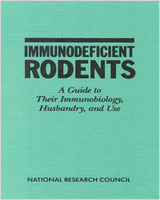NCBI Bookshelf. A service of the National Library of Medicine, National Institutes of Health.
National Research Council (US) Committee on Immunologically Compromised Rodents. Immunodeficient Rodents: A Guide to Their Immunobiology, Husbandry, and Use. Washington (DC): National Academies Press (US); 1989.

Immunodeficient Rodents: A Guide to Their Immunobiology, Husbandry, and Use.
Show detailsIn 1974 the Institute of Laboratory Animal Resources, National Research Council, convened the Committee on Care and Use of the "Nude" Mouse to prepare guidelines for maintaining, breeding, and rearing mice homozygous for the autosomal recessive mutation "nude." These mice, which have thymic aplasia and a developmental defect in hair growth, are difficult to maintain because of their severely compromised T-cell immunity and, consequently, their lack of resistance to many microbial diseases. With their increasing use as animal models, especially in the fields of immunology, oncology, and infectious diseases, it was recognized that guidelines were needed to ensure the production and maintenance of healthy animals. The committee's 1976 report, Guide for the Care and Use of the Nude (Thymus-Deficient) Mouse in Biomedical Research, provided such guidelines.
Since then many immunodeficient rodents have been identified, and the study of these models has increased our understanding of the development and function of the immune system. Concurrently, there has been a broadened awareness of the increased susceptibility of immunodeficient rodents to various infectious agents. New construction materials, shipping containers, and animal-care equipment have helped to protect these animals from disease-producing agents. Many immunodeficient strains are now commercially available in the pathogen-free state and are maintained under rigid quality-assurance programs to guarantee their microbial and genetic status. Each of these innovations, however, places greater pressure on the users of these models to plan in advance for their selection, transportation, housing, and maintenance.
The information contained in this volume is intended to assist investigators in selecting appropriate models for immunologic research. Current knowledge about the maintenance and breeding of these models is also included. The Committee on Immunologically Compromised Rodents has designed this book to be used in conjunction with several National Research Council publications, particularly the Guide for the Care and Use of Laboratory Animals, which was prepared by the Institute of Laboratory Animal Resources (ILAR) and published in 1985 by the U.S. Department of Health and Human Services.
The committee extends its appreciation to the contributors of this volume and to the staff of ILAR, especially Dr. Dorothy Greenhouse and Judith Grumstrup-Scott. Their dedication to and support of the committee have made the publication of this document possible.
Fred W. Quimby, Chairman
Committee on Immunologically Compromised Rodents
- Preface - Immunodeficient RodentsPreface - Immunodeficient Rodents
- sluggish A, isoform L [Drosophila melanogaster]sluggish A, isoform L [Drosophila melanogaster]gi|386764851|ref|NP_001245794.1|Protein
Your browsing activity is empty.
Activity recording is turned off.
See more...